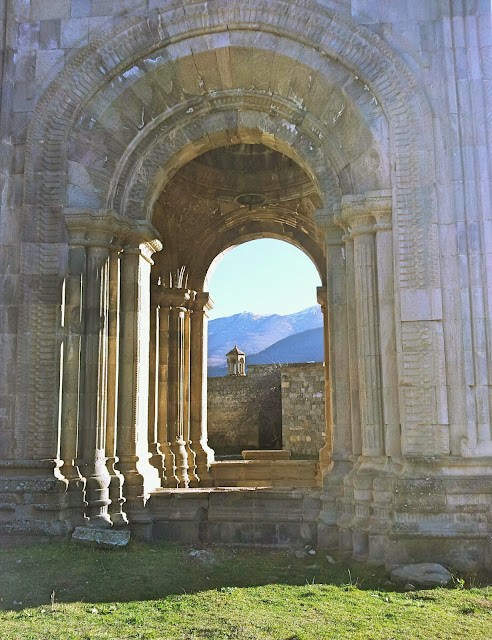Having spent a comfortable pagan night camped amongst the stone sentinels my morning began with another high pass to reach. At 2260m it was only a few hundered short of Selim and constituted a hearty mornings work.
But safe in the knowledge that my destination for the day, Goris, was only 25k beyond I could relax and enjoy the growing majesty of the surrounds.
It hadn't rained here for days but the snow hung on even on the road side making me glad of warm gloves and hat despite the high sun and bitterly lamenting the loss of my buff as the cold wind came down off the peaks.
Having begun the long downhill I spotted a sign for a southerly diversion to Tatev Monastry. I recalled Grisha from YMCA Spitak raving about Tatev so without hesitation I went to see what there was to see.
 The emphatic answer was a gorge. The same one that had further up its course eluded me was here laid out in all its steep sided glory. Complete with table top canyon side opposite.
The emphatic answer was a gorge. The same one that had further up its course eluded me was here laid out in all its steep sided glory. Complete with table top canyon side opposite.I was pleased to see a sign for a cablecar which would whisk me across to the Monastry. At over 5000m long it claims to be the longest in the world. All I know is that it took 11 minutes for me to wing my way across watching the lazy loops of the road below.
The monastry complex was more than worth the trip; perched on the valley side commanding impressive views.
The plateau has hosted a church since the 4th Century (which replaced a pagan temple) The Monastry which still stands now was begun in the 9th Century reaching its hight as both a spiritual and intellectual centre 11th Century when over 1000 monks lived and worked within its walls.
Earthquakes and Soviet neglect brought the monastry low but a process of rebuiding has now begun in earnest.
One of the most interesting secrets revealed here is the Gavazan. This column can sway at any 360 degree angle from it's base. Its function is usually explained as an early warning system for seismic activity.
An alternative but less persuasive idea is that it was a defensive measure - reports suggesting invading Seljuk Turks fled from the demon possesed tower sound too good to be true.
I also had occassion to continue my burgeouning love affair with Armenian doors.

It may be getting out of hand

But you've got to admit they're really very fetching
As were the Katchkar-esque etchings to be found decorating the walls
With a final backward glance I began the steep descent to the valley bottom in search of the Devil's Bridge.
The swtichbacks with had seemed so gentle from above were anything but. Nonetheless I arrived safely at the bottom and followed the stairs down towards the water gurgling below.
Never mind the bridge; the cliff walls were pure Lovecraft with twisting faces seeming to leer down.
While this watery grave did nothing to improve the eerieness
Unfortunatley Satan's Bridge itself was a big ol' let down.
Rubish everywhere compunded the unsympathetic green walkways which served only to obscure the rock butress which forges the river providing a miraculous natural crossing point.
All very disapointing especially as I now had to climb up and out of the valley in payment for this most unspectacular of views.
Ho hum, nothing for it but to get on with it.
Just before I reached the top, as if in reward for the effort, I spied a thrusting rock promonetry jutting out into the canyon.
Now who could resist that?
Walking out along the narrow fairy tale path I swiftly reached the stone Gazebo.
Providing excellent views
Having regained the valley top I hurried off to the river side town of Goris full of solid square stone houses and a relaxed pace of life. Without hesitation I took a hostel bed and the chance to wash some clothes.
The next day I spent exploring Goris's remarkable hillside caves.
Her rock spires bear a striking resemblence to the fairy chimnies of Cappadocia and are formed of similarly soft, excavatable volcanic rock.
Those caves remain in use to this day, often as stables sometimes as homes, lending the old east side of the city a hobbity flavour.
And providing wonderful entertainment for me. Unsaddled with the bike I was able to hike up into those odd looking hills and spend many hours in the sunnshine picking myway along goat tracks to peer into caves.
I am a man of simple pleasures.



















No comments:
Post a Comment